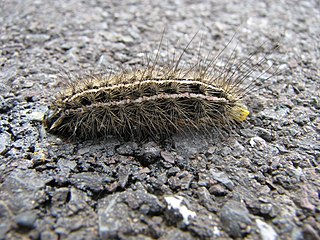
The Arctiinae are a large and diverse subfamily of moths, with around 11,000 species found all over the world, including 6,000 neotropical species. This group includes the groups commonly known as tiger moths, which usually have bright colours, footmen, which are usually much drabber, lichen moths, and wasp moths. Many species have "hairy" caterpillars that are popularly known as woolly bears or woolly worms. The scientific name of this subfamily refers to this hairiness. Some species within the Arctiinae have the word tussock in their common name due to people misidentifying them as members of the Lymantriinae based on the characteristics of the larvae.
Smerinthus jamaicensis, the twin-spotted sphinx, is a moth of the family Sphingidae. The species was first described by Dru Drury in 1773.

Theretra nessus, the yam hawk moth, is a moth of the family Sphingidae. It was described by Dru Drury in 1773.

Apantesis is a genus of tiger moths in the family Erebidae first described by Francis Walker in 1855.

Phragmatobia fuliginosa, the ruby tiger, is a moth of the family Erebidae.

Estigmene acrea, the salt marsh moth or acrea moth, is a moth in the family Erebidae. The species was first described by Dru Drury in 1773. It is found in North America, the Democratic Republic of the Congo, Kenya, Colombia and Mexico.

Argina astrea, the crotalaria podborer, is a moth of the family Erebidae. The species was first described by Dru Drury in 1773. It is found in eastern Africa, southern Asia of India, Sri Lanka, and Indo-Australia, including the Pacific Islands and Australia.

Grammia arge, the arge moth or arge tiger moth, is a moth of the family Erebidae. The species was first described by Dru Drury in 1773. It is found in North America from Quebec and Maine to Florida, West to New Mexico, North to North Dakota and Ontario.

Cyana puella is a moth of the family Erebidae. It is found in the north-western Himalayas, Nepal, India, Sri Lanka, Madagascar, Kenya and Eritrea.

Haploa reversa, the reversed haploa, is a moth of the family Erebidae. The species was first described by Stretch in 1885. It is found in North America, from south-eastern Illinois, Iowa, Kansas, New York, Oklahoma and Wisconsin.
Grammia virgo, the virgin tiger moth, is a moth of the family Erebidae. The species was first described by Carl Linnaeus in his 1758 10th edition of Systema Naturae. It is found in North America from Newfoundland south to Florida west to Alberta.

Amerila astreus is a moth of subfamily Arctiinae described by Dru Drury in 1773. It is found from the Oriental region to New Guinea. The species is found in primary and secondary habitats ranging from lowlands to montane regions.
Apantesis carlotta, or Carlotta's tiger moth, is a moth of the family Erebidae. It was described by Douglas C. Ferguson in 1985. It is found in the US from Maine to Georgia, west to North Dakota and Texas.

Grammia anna, the Anna tiger moth, is a moth of the family Erebidae. It was described by Augustus Radcliffe Grote in 1863. It is found from Maine to the mountains of North Carolina, west to Nebraska and Arkansas.

Grammia figurata, the figured tiger moth, is a moth of the family Erebidae. It was described by Dru Drury in 1773. It is found in North America from southern Ontario and New Hampshire south to Georgia and west to Colorado and Texas.

Grammia phyllira, the phyllira tiger moth, is a moth of the family Erebidae. It was described by Dru Drury in 1773. It is found in North America from Quebec and New England south to Florida and west to Texas, Colorado and Alberta. The habitat consists of dry, open woodland and grassland. The species is listed as endangered in Connecticut.
Grammia placentia, the placentia tiger moth, is a moth of the family Erebidae. It was described by James Edward Smith in 1797. It is found in the south-eastern United States, from New Jersey to Florida. The habitat consists of dry, sandy open wooded areas, primarily pine barrens.
Grammia williamsii, or Williams' tiger moth, is a moth of the family Erebidae. It was described by Charles R. Dodge in 1871. It is found in North America from the Northwest Territories east to the northern Great Lakes region, New Brunswick and New England. It also occurs throughout the northern Great Plains, south at higher elevations to Arizona and New Mexico, west to south-eastern British Columbia and eastern California.

Apantesis proxima, the Mexican tiger moth, is a moth of the family Erebidae. It was described by Felix Guérin-Méneville in 1844.

Erebus hieroglyphica is a moth of the family Erebidae. It is found from the Oriental tropical countries such as India, Pakistan, Sri Lanka, Bangladesh, Japan, China, Taiwan, Cambodia, Laos, Myanmar, Thailand, Vietnam, Indonesia, Philippines, Malaysia, Singapore, and Korea. The habitat consist of lowland forests.














